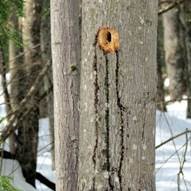How to Prune a "Bleeding" Tree
Editor's Note: This blog post was adapted from a question sent in to TCIA staff by a homeowner, as part of our "Ask the Arborist" series. Got a tree care question? Send it to TCIA Staff Arborist, Tchukki Andersen, at andersen@tcia.org, and we may publish your question on our blog, or in our next issue of the seasonal Tree Care Tips Consumer Newsletter.
 Question: I had my maple tree pruned last spring and afterwards it seemed to leak sap all over the place. Since its spring again, can I have the tree pruned again or will it leak sap again? It was really quite a mess.
Question: I had my maple tree pruned last spring and afterwards it seemed to leak sap all over the place. Since its spring again, can I have the tree pruned again or will it leak sap again? It was really quite a mess.
Answer: A couple of things: first, not every tree needs to be pruned every year. If the tree is younger, then structural pruning can be performed to help shape good architecture so the tree can grow strong. If the tree is older, it might not need any additional pruning – other than perhaps removing dead or hazardous branches.
Second, many types of trees often “bleed” or release sap when pruned in late winter or early spring, before the leaves have developed.
Is This A Bad Thing For the Tree? In late winter to early spring, the sap in the tree starts to rise with warming temperatures, delivering water and sugar to the new leaf buds as they swell in readiness for spring.
Sap is mainly water with some dissolved minerals. Its upward push in the inner trunk (xylem) is in response to root water pressure, which is more intense in the spring than any other time of year. Pruning limbs greater than 3-inches in diameter can cause significant sap loss in the spring.
The sap loss is a minor issue for the tree. Even though stored energy is used to push out the substance, the greater loss is the prior removal of the tree branch - a part of the tree to which the sap would have supplied water and nutrients for energy and growth.
Also, excess quantities of sap running down a trunk or limb can attract harmful insects and disease fungi who feed on the sweet syrupy substance, but it is usually more of an aesthetic nuisance – especially when the sap drips on cars and decks. Of course, if you are in the maple syrup business, you look forward to a productive early spring sap run from your sugar maple trees.
So When Should I Have Sappy Trees Pruned? The best time to prune these “bleeder” trees is in early summer after the leaves have hardened or turned dark green. The sap will still run, but not to the point of depleting moisture and sugar from the tree. Since it is not a close system, like a mammal, the tree will not “bleed to death”.
Late summer pruning is also discouraged because, although there will be no bleeding immediately following pruning, the non- healed cuts will begin to bleed as soon as sap begins to flow in spring.
Examples of prolific sap runner trees:
| Birches (Betula) |
black locust (Robinia) |
| Chinese wingnut (Pterocarpa) |
dogwoods (Cornus) |
| Elms (Ulmus) |
European hornbeam (Carpinus) |
| Honeylocust (Gleditsia) |
maples (Acer) |
| Magnolias (Magnolia) |
walnut (Juglans) |
| Poplars (Populus) |
willow (salix) |
| Sumacs (Rhus) |
|
There is no practical method for stopping the flow of sap from a bleeding wound, and in most cases, this bleeding is completely harmless. Binding and wrapping the cut is not recommended, as it is better to allow air to reach the wound and let it heal naturally.
Find a Professional
Need help determining the best method for pruning your trees? Click here to find qualified tree care in your ZIP code.